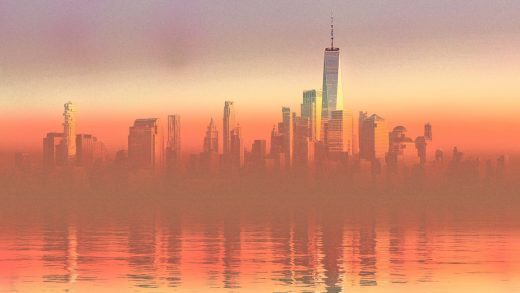Smoke from western wildfires leaves a deadly path as it crosses the U.S.
Even though there have been no major wildfires in the region, East Coasters may have seen some concerning smoke-fueled air-quality warnings pop up on their weather apps this summer. The cause is cross-country plumes from Oregon’s massive Bootleg Fire, drifting all the way across the continent to New York, Philadelphia, and Toronto, 2,500 miles away.
A new study warns that that traveling smoke has detrimental health effects on Eastern populations—in fact, it found that there were more total smoke-induced asthma morbidities and mortalities in recent years in the East than in the West. The researchers say Easterners, and especially those with pre-existing conditions, should be aware of these health impacts and take steps to protect themselves, especially as wildfires are due to worsen in coming years.
Estimating the number of asthma ER visits and hospitalizations that originated from inhalation of hazardous air pollutants from smoke between 2006 and 2018, the Colorado State University researchers found that totals were higher east of the Rocky Mountains. Long-term smoke exposure resulted in 6,300 extra deaths per year—but only 1,700 of those were in the west.
While that finding was surprising to the researchers at first, the total is higher because the Eastern U.S. is more densely populated; after accounting for population density, the rate of ER visits due to related asthma was higher in the West, at about 1%, versus 0.3 to 0.6% in the East. Still, it’s concerning, especially for a population who don’t live in the immediate surroundings of wildfires, and therefore don’t tend to pay much attention to them. “We talk about smoke so much in the West,” says Katelyn O’Dell, a postdoctoral researcher, and one of the authors. “If you’re unaware, you’re potentially more liable to experience these health impacts.”
Smoke is a complex mix of particles, but the main offending particles are tiny ones known as PM2.5—which O’Dell says is thinner than the width of a strand of hair—that can trigger asthmatic problems, as well as lung cancer and heart disease. Smoke plumes do dissipate in severity as they travel, especially over thousands of miles, causing particle concentrations to dilute, but O’Dell says previous studies have shown that long-term exposure to PM2.5 can still be harmful in those low concentrations. Other gases that appear in the atmosphere from fires, such as acrolein and formaldehyde, can also be dangerous, though probably less so over that distance.
O’Dell says it’s critical for people in the East to be more aware of the risk. When you don’t see the grim effects of fires firsthand, and don’t have to adapt your lifestyle because of them, you may not consider them to even exist in your surroundings. In Colorado, “I had to change the way that I was living my life,” says O’Dell, who’s now at George Washington University. In the East: “When you see orange skies, that’s a pretty sunset,” she says, “but in the West, it looks like the apocalypse is happening in your backyard.”
Once people know of the danger, they can take steps to help protect themselves, and especially those most at risk, including children, the elderly, and people with conditions like asthma. People should stay inside and run air filters when the air quality is very bad; when it’s less so, perhaps wind an outdoor intensity run down to a walk. And, wear masks, preferably N95s or KN95s. “That’s a suggestion that people didn’t really talk about [before],” O’Dell says, “because it was like, ‘Who’s going to wear a mask? No one has a mask.”
At the same time, local and state governments, even in the East, should improve warning systems and ensure they’re accessible. And, work to reduce air pollution of other kinds, such as in car exhaust fumes and industrial emissions, because they also contribute to the total amount of PM2.5 in the air.
Still, because wildfires are likely to increase every year in frequency, and in the amount of areas they burn, they will cause even more PM2.5 pollution. So the expectation among scientists, O’Dell says, is that “smoke will be the main source of those particles in the U.S. by the end of the century.”
(21)



